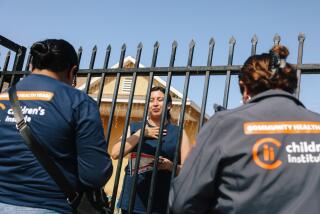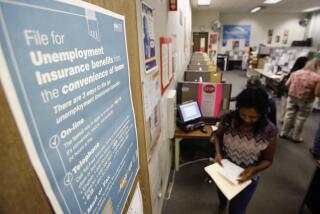To Phase Out Aid, Farm Belt Needs New Crop of Jobs
- Share via
SACRAMENTO — In California’s verdant farm belt, far from the alleys and asphalt of urban poverty, welfare reform is encountering two great obstacles: the highest unemployment and the heaviest welfare dependency in the state.
While lawmakers and advocates focus on urban areas with vast numbers of welfare recipients, it is the less populous, small agricultural counties up and down the state that pose particularly tough hurdles for those implementing the reform law.
“Everybody looks at Los Angeles and San Francisco, but they better think about what [welfare reform] means in the rural areas,” said Eloise Anderson, director of California’s Department of Social Services. “I think what they see is that this is an urban issue. It’s not an urban issue. [Welfare is] more integrated into the rural economy than it is in the urban economy.”
In the rural counties, Anderson said, the overwhelming challenge will be to find jobs for large numbers of welfare recipients while unemployment is still in double digits.
A Times analysis of state data found:
* More than 20% of the populations in Fresno, Merced and Tulare counties in the fertile Central Valley are on public assistance, and unemployment hovers between 12% and 16%.
* More than a third of the people who live in sprawling Imperial County, near the Mexican border, are unemployed, and nearly one in four receives welfare.
* In the timber belt in Northern California, Glenn County has a 19% unemployment rate--and of the 17% of its population that is receiving public assistance, almost one-third are Hmong refugees from Laos.
“We see welfare reform as kind of like fighting with your hands tied behind your back,” said Glenn County Social Services Director Kim Gaghagen. “You can see the punches coming, but what are you going to do about them?”
Nowhere is welfare reform expected to leave deeper marks than in the rural areas. For decades, public assistance has been an integral part of an economy heavily dependent on seasonal work from an immigrant labor force.
The most pessimistic outlook sees an increase in hunger and homelessness, a return to the kind of grinding poverty that Robert Kennedy highlighted during his 1968 quest for the presidency.
Others predict less dramatic impacts, anticipating that the scarcity of jobs and the resources needed to create new ones will spawn a wave of migration from farms to cities and suburbs.
“Something I don’t think was really considered in the welfare discussion was the capacity of local economies to address employment issues,” said Kenneth Entin, a political science professor and demographer at Cal State Stanislaus. “The challenge of welfare reform is a little different in counties where the annual unemployment rate is 15%. Where are the jobs going to be?”
For state government leaders, the problems of rural California are expected to become a pivotal issue in the welfare debate and to discourage a one-size-fits-all approach to a final welfare plan that would tether agricultural counties to the same systems as those designed for urban counties.
“I’m very concerned that the counties really have to have a lot of freedom,” Anderson said. “[Welfare reform] is not a statewide issue. It’s community by community by community.”
*
On a rolling country road just outside of Turlock, Lori Richie, 23, waited in front of a small cluster of dilapidated apartments for the truck from the nonprofit United Samaritan Foundation that would give her a free bag lunch. A solemn-faced child stood beside her, clinging to the hem of her Bermuda shorts.
The free lunch helps supplement the welfare payments Richie gets to support a disabled husband, an 8-month-old son and a 4-year-old daughter. Under welfare reform, Richie will soon have to get a job or lose some of these benefits.
Although she acknowledged she doesn’t have much work experience, the idea of a job pleases Richie. She thinks she has an advantage too. She has a car, a husband who could baby-sit and a high school education. But then her face clouds over.
“I’ve put a application in at a lot of places. I’ve been trying for a year to get something,” she said. “There’s nothing.”
What will people do if they can’t find work? Marie Masquart, a streetwise former drug user who’s proud of being clean and off welfare, answered quickly. “Sell drugs,” she said matter-of-factly. “A lot of folks are going to start selling drugs.”
Turlock, an agricultural and food processing center in Stanislaus County with a population of 49,800, is typical of rural communities struggling with welfare reform. Unemployment is persistently high, child poverty is extensive and the work force is predominantly low-income and unskilled.
Carolyn Ratto, the mayor pro tem, said that as a political concept welfare reform was very popular in Turlock but residents are less sure now that the plan is being implemented.
She said they worry about whether there will be adequate numbers of jobs for welfare recipients, as well as transportation and child care for them. The city has no fixed-scheduled bus system and is already grappling with a shortage of child care.
Law enforcement officials have other fears. In recent years, they say, the Turlock area has become a center for the manufacture of illegal drugs, particularly methamphetamines. Farmers have found mobile meth labs hidden in the middle of cornfields where they operated undetected until harvest time.
Steven D. Bynum, community crime resistance coordinator for the city, said many Los Angeles gang members have settled in Turlock because they don’t have to worry about competition from rival gangs.
“If we end up with a lot of welfare recipients who are out of work, a lot of these gangs can go to them and say, ‘Look, we can double the money that you were making on welfare and all you have to do is manufacture this drug.’ ” Bynum said. “We haven’t even mapped out a strategy for dealing with consequences like these. I worry that these gangs are more organized and better prepared for welfare reform than we are.”
*
Even though the rest of the state is experiencing a business boom, the agricultural communities still have not rebounded completely from the last recession. The recession, said Don Villarejo, executive director of the California Institute for Rural Studies, hit harder in the farm belt, producing about 50% higher unemployment than in urban areas.
“The trend is very, very clear,” he said. “Every time we’ve had a recession and the rural unemployment rate has increased, then recovered, it doesn’t drop quite as low as it was before. So we’re ending up with just this gradual increase in overall levels of unemployment.”
J. Edward Taylor, professor of agricultural and economic resources at UC Davis, said welfare reform may slow the recovery even more as the flow of government assistance to rural economies is staunched by time limits and the elimination of food stamps and Supplemental Security Income for some legal immigrants.
The reduction in welfare dollars, he said, will not only affect individual families but will eventually trickle down to all the merchants who provide them goods and services.
Because a large portion of the population in most rural counties is receiving assistance, Taylor said the eventual loss of welfare dollars as recipients are removed from the rolls will have a substantial impact on local economies. In urban centers such as Los Angeles, welfare dollars represent only a tiny percentage of the local economy, he said, but in many rural towns their contribution to the economy is huge.
“If you look at the Los Angeles economy before and after welfare reform, I would be surprised if there is even much of a blip,” Taylor said. “Whereas in a community like Orange Cove in Fresno County, you’re going to see some big changes.”
The impact of welfare reform on the rural economy could be softened if there were jobs for recipients, Taylor said, but the biggest employer--agriculture--already has a plentiful labor supply because of the influx of workers from Mexico. Inexperienced, untrained welfare recipients have little chance of competing in this saturated job market.
Besides, said Villarejo, for most welfare recipients--especially mothers who receive Aid to Families With Dependent Children--heavy farm work is really not an option.
“There’s a reason why young Mexican men are the predominant component of the farm labor force and why they outperform basically other subgroups,” he said. “They’re very good at it, they work hard and they’re very experienced. And I don’t think the people on AFDC who the government said should go to find a job are going to be able to compete with these people.”
The challenge of welfare reform in rural areas also is magnified by a paucity of resources. With their sparse populations, isolation from large urban centers and small tax base, there are few government funds to invest in job training or job creation.
In the competition for federal government grants, local officials say they lose out to the big urban centers every time.
“We’re at the bottom of the barrel when it comes to getting funding for anything,” said Ratto, Turlock’s mayor pro tem. “Our percentages per capita are extremely high for things like child poverty or violence, but our total numbers can’t compete against the big cities.”
And rural communities rarely have food banks and other charitable services that help ease the impact of cuts on the poor.
“If you run out of your food stamps in Oakland, you go to the soup kitchen,” said Laurie True, research and policy director for California Food Policy Advocates. “Here you run out and you are usually hungry. There’s no social services infrastructure. There are few food banks and soup kitchens and self-help centers that are run by do-gooders.”
County officials contend that they are exploring every possible avenue to create jobs for welfare recipients, including joining forces with other rural counties to promote economic development.
“We want to put an all-out effort into trying to get people into jobs, but we also have to be realistic. Where are we going to place them?” said James Semmes, Imperial County social services director.
Thomas MaCurdy, a senior fellow at the Hoover Institution and a Stanford University economics professor, said the solution for many counties may be to encourage migration to other areas where work is more plentiful.
In fact, he said, it may become the role of the state to provide travel grants or other assistance that would motivate people to move where the jobs are.
“This is going to have to be a situation where people aren’t going to be able to live where they want to necessarily,” he said. “I mean, very often it’s going to be a lot easier to move welfare recipients to jobs than try to move jobs to welfare recipients.”
(BEGIN TEXT OF INFOBOX / INFOGRAPHIC)
Welfare Counties
Here is a county-by-county look at welfare recipients in California:
Top 10 counties according to their % of welfare recipients:
*--*
No. on % on % County Population Welfare Welfare on Jobless Yuba 62,200 19,077 30.7% 13.9% Merced 198,600 59,372 29.9% 16.2% Imperial 140,100 39,065 27.9% 29.4% Tulare 361,600 91,509 25.3% Fresno 760,900 189,319 24.9% 13.0% Lake 55,300 12,549 22.7% 11.4% Alpine 1,180 265 22.5% 9.7% Del Norte 28,650 6,303 22.0% 10.2% San Joaquin 529,300 113,778 21.5% 11.2% Madera 108,900 23,189 21.3% 14.1%
*--*
****
State’s most populous counties and their numbers of welfare recipients:
*--*
No. on % on % County Population Welfare Welfare on Jobless Los Angeles 9,369,800 1,602,768 17.1% 8.2% San Diego 2,890,300 310,299 10.7% 5.3% Orange 2,624,300 229,170 8.7% 4.1% San Bernardino 1,689,500 288,786 17.1% 7.2% Santa Clara 1,612,300 151,459 9.4% 3.6% Riverside 1,381,900 176,235 12.8% 8.2% Alameda 1,356,100 209,170 15.4% 5.1% Sacramento 1,123,400 233,327 20.8% 6.0% Contra Costa 870,700 83,442 9.6% 4.9% Fresno 760,900 189,319 24.9% 13.0%
*--*
Sources: California Department of Social Services; California Employment Development Department; California Department of Finance, Jan. 11, 1996 state population estimates
More to Read
Get the L.A. Times Politics newsletter
Deeply reported insights into legislation, politics and policy from Sacramento, Washington and beyond. In your inbox twice per week.
You may occasionally receive promotional content from the Los Angeles Times.







